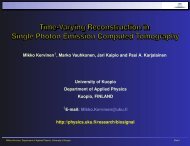USER'S GUIDE - Biosignal Analysis and Medical Imaging Group
USER'S GUIDE - Biosignal Analysis and Medical Imaging Group
USER'S GUIDE - Biosignal Analysis and Medical Imaging Group
- No tags were found...
You also want an ePaper? Increase the reach of your titles
YUMPU automatically turns print PDFs into web optimized ePapers that Google loves.
3.2. Frequency-domain methods 23In addition to the above statistical measures, there are some geometric measures thatare calculated from the RR interval histogram. The HRV triangular index is obtained asthe integral of the histogram (i.e. total number of RR intervals) divided by the height of thehistogram which depends on the selected bin width. In order to obtain comparable results,a bin width of 1/128 seconds is recommended [44]. Another geometric measure is the TINNwhich is the baseline width of the RR histogram evaluated through triangular interpolation,see [44] for details.3.2 Frequency-domain methodsIn the frequency-domain methods, a power spectrum density (PSD) estimate is calculated forthe RR interval series. The regular PSD estimators implicitly assume equidistant sampling<strong>and</strong>, thus, the RR interval series is converted to equidistantly sampled series by interpolationmethods prior to PSD estimation. In the software a cubic spline interpolation method isused. In HRV analysis, the PSD estimation is generally carried out using either FFT basedmethods or parametric AR modeling based methods. For details on these methods see, e.g.,[27]. The advantage of FFT based methods is the simplicity of implementation, while the ARspectrum yields improved resolution especially for short samples. Another property of ARspectrum that has made it popular in HRV analysis is that it can be factorized into separatespectral components. The disadvantages of the AR spectrum are the complexity of modelorder selection <strong>and</strong> the contingency of negative components in the spectral factorization.Nevertheless, it may be advantageous to calculate the spectrum with both methods to havecomparable results.In this software, the HRV spectrum is calculated with FFT based Welch’s periodogrammethod <strong>and</strong> with the AR method. Spectrum factorization in AR method is optional. Inthe Welch’s periodogram method the HRV sample is divided into overlapping segments.The spectrum is then obtained by averaging the spectra of these segments. This methoddecreases the variance of the FFT spectrum.The generalized frequency b<strong>and</strong>s in case of short-term HRV recordings are the very lowfrequency (VLF, 0–0.04 Hz), low frequency (LF, 0.04–0.15 Hz), <strong>and</strong> high frequency (HF,0.15–0.4 Hz). The frequency-domain measures extracted from the PSD estimate for eachfrequency b<strong>and</strong> include absolute <strong>and</strong> relative powers of VLF, LF, <strong>and</strong> HF b<strong>and</strong>s, LF <strong>and</strong>HF b<strong>and</strong> powers in normalized units, the LF/HF power ratio, <strong>and</strong> peak frequencies for eachb<strong>and</strong> (see Table 3.1). In the case of FFT spectrum, absolute power values for each frequencyb<strong>and</strong> are obtained by simply integrating the spectrum over the b<strong>and</strong> limits. In the case ofAR spectrum, on the other h<strong>and</strong>, if factorization is enabled distinct spectral componentsemerge for each frequency b<strong>and</strong> with a proper selection of the model order <strong>and</strong> the absolutepower values are obtained directly as the powers of these components. If factorization isdisabled the AR spectrum powers are calculated as for the FFT spectrum. The b<strong>and</strong> powersin relative <strong>and</strong> normalized units are obtained from the absolute values as described in Table3.1.3.3 Nonlinear methodsConsidering the complex control systems of the heart it is reasonable to assume that nonlinearmechanisms are involved in the genesis of HRV. The nonlinear properties of HRVhave been analyzed using measures such as Poincaré plot[5, 6], approximate <strong>and</strong> sampleentropy [40, 12], detrended fluctuation analysis [36, 37], correlation dimension [15, 17], <strong>and</strong>Kubios HRV <strong>Analysis</strong>version 2.0 beta<strong>Biosignal</strong> <strong>Analysis</strong> <strong>and</strong> <strong>Medical</strong> <strong>Imaging</strong> <strong>Group</strong>Department of PhysicsUniversity of Kuopio, FINLAND





